29/09/2023
Best Graphic Tablets for Clip Studio Paint
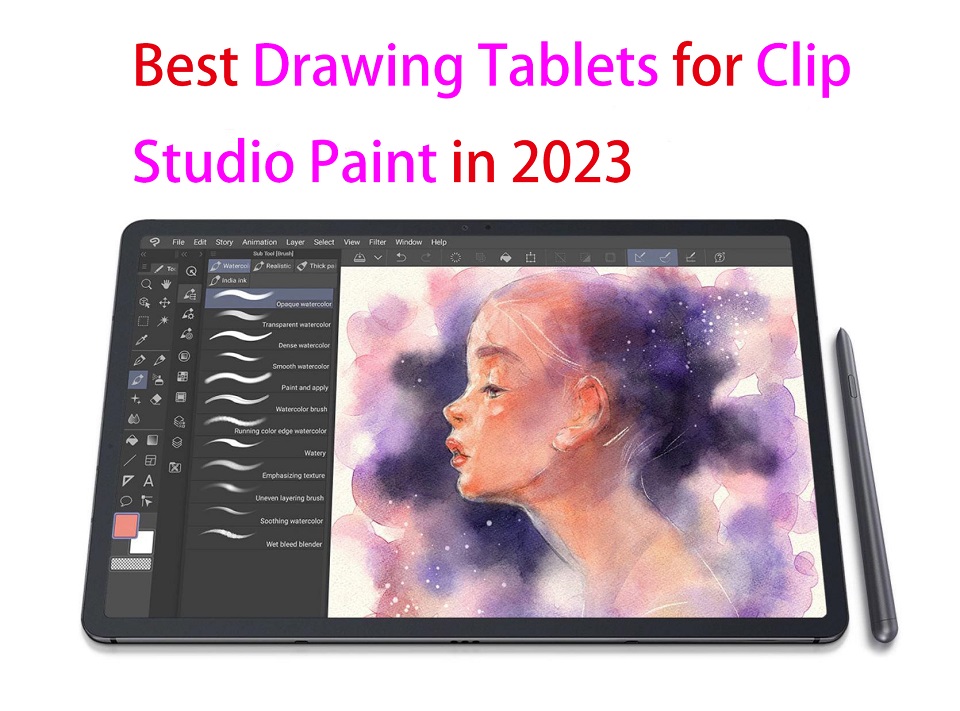
Clip Studio Paint is one of the most popular software for digital art, illustration, comic, and 2D animation.
To draw in Clip Studio Paint, you need a graphics tablet. It can be any tablet, small or big, with or without a screen—as long as it supports pressure sensitivity.
The best drawing tablets for Clip Studio Paint are devices with high levels of pressure sensitivty, large drawing area and of course, a vivid, sharp display that accurately represents the colors you're working with in the software.
If you're most interested in power while also being portable, there are many standalone tablet support pen input , so you can take wherever you go and create art anywhere.
Sometimes it is very hard to choose the perfect tablet for Clip Studio Paint since there are many different models, types, and brand options available on the market.
That's why we've made this list, to ensure you get the best option for you. We will also explain what makes them stand out from the crowd.
If you don't know what to consider when choosing a tablet for Clip Studio Paint, We hope the buying guide below will be helpful to you.
What is Clip studio Paint?
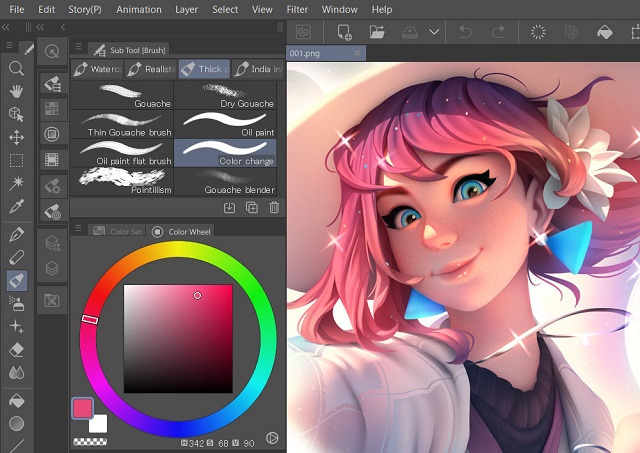
Clip Studio Paint, previously Manga Studio or ComicStudio in Japan, is a family of software applications for Android, iPad OS, Mac OS X and Microsoft Windows used for the digital creation.
Clip studio Paint is a good all round alternative to Photoshop or Corel Painter and it doesn't stress out your computer.
CSP has all the tools you could need for drawing, it's a very extensive drawing software compared to other ones out there.
Clip Studio paint have excellent line correction, the default brushes are impressive, and the brushes are much easier to customise because it has a stabilization setting for your brushes as well as a blending tool.
You can also download and add pens, brushes, tones, etc, from Clip Studio ASSETS, the official material library, and import Photoshop brushes.
In addition to pens and brushes, it has many other digital art tools such as gradients, filters, and layer effects.
If you like comic and manga there are really awesome features for it in CSP to speed up your workflow, something like comic panels, comic page, comic cloud, balloons, tones, perspective rulers, and etc.
It also has animation tools, the easy-to-manage animation timeline, rulers, abundant collection of assets, 3D and more.
This drawing software also gives you access to plenty of assets including characters, backgrounds, props and effects that you can quickly add to your panels.
There are over 10,000 free assets, and many more available for a few dollars each.
It also has a reasonable price point, you can get it with a one-time payment or subscription, and because it is adaptable, it is suitable for both novice and experienced users.
Benefits of Using a Drawing Tablet With Clip Studio Paint
You can still use your mouse and keyboard to work with Clip Studio Paint. However, a drawing tablet significantly increases your motor control with a stylus and improves your workflow by giving you special features and extra tools to work with.
Tablets equipped with pressure-sensitive provide artists with precise control over their strokes. This feature allows for varying line thickness and opacity, enabling artists to achieve intricate details and create dynamic shading effects in their digital art.
Using a mouse for drawing can potentially lead to carpal tunnel and other injuries. drawing with a pen is more natural, comfortable and ergonomic, which can reduces strain on your hand and wrist.
Using a drawing tablet can be more efficient than using a mouse or touchpad. With hotkeys on the tablet, you can quickly switch between drawing and selecting tools, making it easier to work quickly and efficiently.
Factors to consider when choosing a drawing tablet for clip studio paint
1. Types of tablet
A non-display drawing tablet is a regular graphics tablet with a black drawing surface. You connect it to a computer via a USB cable or wireless and look at your monitor while drawing on the black surface.
This can certainly take some getting used to, but starts to feel natural after a while.
Display drawing tablets, on the other hand, work the same as pen and paper but are considerably more expensive than non-display drawing tablets.
You simply trace lines on the drawing tablet with your drawing pen and they appear on the tablet screen. This is more intuitive, natural and easy to adapt to.
Another thing to remember is that these two types of tablet above still require a computer to connect to work.
Standalone tablet type is the more portable option, as they have built-in screen and function independently from bulky devices like computers. This is a great option for artists who travel a lot.
2. Size
Drawing tablet sizes consist of two different factors – the working area and the device area.
The working area is the section of drawing tablets that is responsive to pen input and this area's size is important for comfort and detail.
The device area includes the portion of the drawing tablets that frames the working area and often includes shortcut controls.
In order to consider the device size, you need to look at the space available on your desk, Portability and the size of your computer screen.
We recommend you get a large tablet because it has a big active working area which is more convenient for drawing or manipulating images on a large scale.
3. Display
The display is a factor to consider if you're getting a tablet with a screen.
Normally, a display with full HD resolution works just fine. however, owning a better resolution like 2K or 4K display will represent a huge advantage for any kind of creative work.
If you work with colors a lot, it's a good idea to get a display that covers a large range of colors above 100% sRGB.
If what you need is portability, going for tablets from 10” to 16” would be the best choice. If you do a lot of illustrations, We would recommend going for a 22-inch or larger size.
4. Pressure Sensitivity
The most important feature of a drawing tablet is its pressure sensitivity.
How thick and opaque the lines are, based on how hard you press down on the tablet with the pen.
The higher the pressure sensitivity, the better you can control the line weight.
2,048 levels of pressure sensitivity is plenty. However, If you're more advanced, your tablet should have at least 4,096 pressure levels.
5. Tilt Detection
Tilt detection is another feature you may want to consider.
Tablets with this feature can track the angle of the pen and use this to vary the thickness and intensity of the line – ideal for sweeping brushwork or interesting calligraphy effects.
6. Stylus
There are different types of stylus: with or without battery.
Battery-free stylus don't need batteries or any wires to function, reducing maintenance and weight for a more natural pen feel.
The stylus of Wacom, huion and XP-Pen is battery free and use EMR technology which receives its power from the tablets.
Rechargeable stylus need charging just like your phone or laptop, like the Apple Pencil for iPad and S Pen for Samsung tablets.
If they run out of battery you will have to find a power source to charge before you can draw again.
Some standalone tablets like apple ipad and microsoft surface don't come with a pen, so you'll have to get the pen separately.
7. Operating System
There are certain tablets that only support a specific operating system, for example, iPad Pro only works for macOS, samsung galaxy tab only runs on android and Microsoft Surface only supports Windows OS. So it's a good idea to check the specifications before placing your order.
Luckily, most traditional drawing tablets work for both Mac and Windows, so you can use the tablet for different devices that you have.
8. Brands
Wacom used to be the only real choice. They're still the best.
But now you can also get good tablets from Huion, XP-Pen, and others.
They have enough features to compete with mid-range Wacoms, and you can save a lot of money with one of those brands.
For standalone drawing tablets, apple, microsoft, and samsung are the most well-known brands.
9. Additional Features
Many traditional tablets will include additional features like hotkeys, wireless connectivity and accessories that are required to streamline your artistic process.
For standalone drawing tablet, you also need to pay attention to tech specs include processor, ram, storage, graphics card and battery life.
10. Price and Budget
Cost is a crucial factor for some as not everybody has a professional's budget.
Budget drawing tablets would be tablets without screen, such as Wacom Intuos, huion inspiroy or xp-pen deco. You can easily find a decent tablet for under $100, especially for hobby art.
Display tablets, like wacom cintiq, Huion kamvas or xp-pen artist, are much more expensive and would probably be better suited for professionals rather than hobbyists.
Standalone drawing tablets, like ipad pro, surface pro or samsung galaxy tab, are the most expensive in general.
10 Best Drawing Tablets for Clip Studio Paint
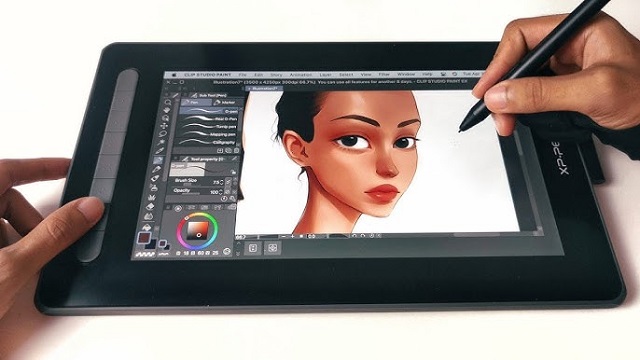
After a deep analysis and research, we've gathered the best drawing tablets for Clip Studio Paint.
Each tablet has its advantages and disadvantages. Take a look and decide for yourself.
1. Wacom Intuos
2. XP-Pen Deco 01 V2
3. XP-Pen Artist 12 (2nd Gen)
4. Huion Kamvas 13
5. Wacom Cintiq 16
6. Huion Kamvas 22 Plus
7. XP-Pen Artist 24 Pro
8. iPad Pro
9. Samsung Galaxy Tab S9
10. Surface Pro 9
Setting Up a Drawing Tablet wth Clip Studio Paint
In order to make your drawing tablet work in clip studio paint you should configure it first.
1. Plug the cable ports to connect the tablet and PC. Once you attach the drawing tablet, it will start working.
2. Now after connecting the drawing tablet, driver installation must be done.
To install the driver, first go to the drivers page on the manufacturer's website.
Download the driver for your operating system depending on whether you're using a Mac or Windows.
Once you have installed the drivers for your drawing tablet, you can adjust the settings to fit your preferences.
This can include adjusting the pressure sensitivity, mapping the tablet to your screen, and customizing the buttons on the stylus pen.
3. After driver installation, if you are using Windows, restart the computer. If you are a Mac user, there is no need to restart the system.
4. In clip studio paint you must add the tablet once.
After running Clip Studio Paint, click "File" at the top left to open the drop-down box and select "Preferences" in the drop-down box to open
In the Preferences window, open the "Tablet" interface, select "TabletPC" , and then click "OK". Also choose Save (or else it will forget your choice).
After the above settings are completed, be sure to restart Clip Studio Paint.
5. Once you have set up your drawing tablet, you can start creating digital art.
Conclusion
These 10 tablets are all worthy options for any level of digital artist out there.
The big difference for you to decide will be between the type of tablet you purchase.
Screenless, screen and standalone type tablets are all fantastic tools for drawing in Clip Studio Paint, so you can't go wrong either way!
It all boils down to what your preferences and budget are. If you've got a small budget to start with, pick something cheaper from our list and start with that.
As you grow, you can upgrade to something a little more loaded with features.
We hope this article was helpful and that you were able to find the perfect device for Clip Studio Paint.
Source: https://pctechtest.com/best-drawing-tablets-for-clip-stud...
03:22 Publié dans Perso | Lien permanent | Commentaires (0)
24/09/2023
Best Pen Tablets for drawing tattoo sketches

Today tattoos are everywhere, and it's an expression of art, and anyone can have it by their own choice.
Tattoo artists are always in need of the most modern technology so that they can create their artwork. Creating digitally has become more and more popular among them.
While pencil and paper is always an option for designing your tattoos, there are tons of digital drawing tablets out there that can save you time and help you create complete designs to show potential clients.
You can enjoy the convenience of security and backup, a wide range of softwares and tools, the option of portability, etc.
Additionly, With the undo button on tablet, mistakes can always be easily erased. with clever use of layers in the art software you can change composition on the fly.
It's 2023 and whether you want to accept it or not, smart devices like iPads, Wacoms, samsung tablets, and more have become a huge asset to tattoo artists.
For artists who want to draw tattoo sketches, such tablets offer a practical and easy route. With some brilliant drawing softwares and tools provided by these tablets, the only other thing you will need is your imagination.
In this article, We will review some of the finest dirawing tablets for you to create tattoo design on. Each of the tablets reviewed in this article has its own benefits.
An important thing to keep in mind when you are considering these tablets is their diversity and variation in features and how they may match your specific artwork requirements.
What is a drawing tablet?
A drawing tablet, also known as a graphics tablet, is a device that allows artists to draw and create digital art using a stylus pen and a touch-sensitive surface.
Beginner drawing tablets behave as an input device for desktops and laptop computers in order to digitize strokes and lines drawn by a stylus pen.
With ergonomic design, pressure-sensitivity, and advanced productivity features, drawing tablet enable you to unleash your creativity and enhance your artistic skills.
Nothing can really top the natural feel and control over using a tablet vs. using a mouse to draw freehand.
What kind of drawing tablets do tattoo artists use?
You can buy a tablet with or without a screen for drawing, like the Wacom, Huion or XP-Pen, which need to be connected to a computer to work.
A graphic tablet without screen is cheapest, but eye-hand coordination can be a problem, because it depend on a computer screen for visualization.
On the other hand, a drawing tablet with a built-in screen allows you to draw directly on with a stylus. This can make the drawing experience feel more intuitive and natural.
However, they are quite large, and often have usually 2 more cables to connect to a PC, making it harder to move around.
Wacom tablets are considered a standard equipment for designers and illustrators around the world, but it'll cost you.
If you are a beginner and want to spend less money. We'd suggest something from XP-Pen or Huion, as they're much cheaper than Wacom but are still quality products.
In addition, you can also buy a standalone tablet supports pen input, Like the Apple iPad, Samsung galaxy tab, or Microsoft Surface, which works as a drawing tablet and won't be needed to connect to any computers.
These tablets are self contained and portable, plus you can get your email, chat, listen to music, watch movies, and do all kinds of things with it. The only drawback is they are more expensive in general.
You can trust in these brands mentioned here. These brands produce the best drawing tablets, the design and build quality are awesome.
10 Best Drawing Tablets for Tattoo Artists
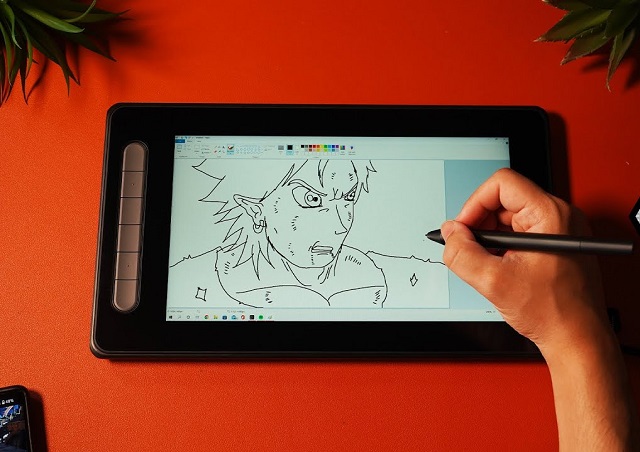
Here is the list of our best drawing tablets for tattoo artists, all of these tablets had great physical aspects and beneficial performance with exceptional comfort to the users.
1. Apple iPad Pro
2. Samsung Galaxy Tab S9
3. Surface Pro 9
4. Wacom Intuos
5. XP-Pen Deco 01 v2
6. Huion Kamvas 13
7. XP-Pen Artist 10 (2nd gen)
8. Wacom Cintiq 16
9. Huion Kamvas 22 Plus
10. XP-Pen Artist 24 Pro
10 Best tattoo design and drawing apps
These 10 drawing apps allow you to create and refine tattoo designs with precision and flexibility before inking them onto your clients' skin.
1. Procreate
Procreate has become the essential tool for digital illustration on the iPad due to its intuitive interface and the variety of resources and artistic styles for which it can be used.
Procreate is also an excellent tool for tattoo artists. Its diverse range of brushes and customizable features allow them to create highly detailed and precise tattoo art.
Procreate is only available on the iPad OS at an one-time payment of $12.99 USD.
2. Adobe Photoshop CC
Adobe Photoshop CC is a software program that allows users to manipulate images and create digital artwork.
It is often used by graphic designers and photographers to edit photos or create new designs. However, it can also be used to create tattoo designs.
It is available for Windows and Mac OS. With $20.99 monthly subscription, Adobe's pricing model is good for short-term users and those who want constant upgrades.
3. Adobe Illustrator CC
Adobe Illustrator CC is a vector-based graphics software and one of the most intuitive tattoo drawing apps.
It is easy to use and allows you to draw lines, shapes, and text to create intricate designs.
Illustrator is available for Windows and Mac OS. you can get it together with photoshop as part of the Creative Cloud All Apps plan.
4. Clip Studio Paint
Clip Studio Paint is used for the digital creation of comics, general illustration, and 2D animation.
It has tools powerful enough for professional work while being intuitive enough for anyone! Many artists use it to create perfect line art for tattoo stencils.
Prices begin at $4.49 per month or $49.99 for a perpetual license. The software is available in versions for macOS, Windows, iPadOS, Android, and ChromeOS.
5. Adobe Fresco
Adobe Fresco is an excellent drawing program that offers numerous tools and a great variety of brushes to help you be as creative as you like.
There are watercolors, oils, vectors, and raster brushes that you can use when working on the same canvas. Besides, when creating sketches you can benefit from Adobe Sensei live brushes that perform like real tools.
The app is available on iPad and Windows tablets. You can use it for free, and have access to a limited number of features, but if you want the full experience, you'll need the $10 a year subscription.
6. Sketchbook Pro
SketchBook is an easy to use drawing app for doodlers, tattoo artists, and designers looking to rapidly capture their inspiration and design ideas.
The app includes an intuitive interface with a wide range of natural-media painting tools aimed at artists and makes full use of layers to create artwork.
Sketchbook is available for Windows, Mac, android and iPad OS. licences of Windows and macOS cost $19.99, but still free for mobile devices.
7. Medibang Paint Pro
Medibang Paint Pro is a free digital painting and comic creation software. It's available for Windows, Mac, Android and iPad OS.
With over 800 brushes and hundreds of materials, Medibang Paint is an easy and intuitive way to make tattoo art.
It also saves your artwork to the cloud so that you can seamlessly move from one device to the other.
8. Krita
Krita is a free and powerful program for sketching, painting and illustration, It has a very good selection of brushes and tools.
Krita is available on Android, Mac, Windows, and Linux. It is suitable for amateur and professional tattoo artists.
9. Affinity Designer
Affinity Designer is an impressive, low-budget alternative to Adobe Illustrator.
One of the great features of Affinity Designer is that it allows us to use vector and raster techniques in a single image.
It's Perfect for creating vintage tattoo style artwork for t-shirts, poster art, packaging and web graphics.
You can get Affinity Designer with one-time purchase of $69.99 for Windows and Mac, beginning at $19.99 for the iPad version.
10. ibis Paint X
Ibis Paint X is a free, powerful mobile painting app that offers a wide range of features, including layers, brushes, filters, and more.
With its intuitive interface, it is easy to use and navigate, making it a great choice for both beginners and more experienced artists.
It's available for Android and iPad OS. The free version contains a few ads, But you can pay $9.99 one-time to remove the ads permanently .
If you want to access more features of ibis Paint X, you can choose the monthly ($2.99 USD per month) or yearly ($27.99 USD per year) subscription plan.
Conclusion
To produce quality tattoo design work, you need both the right skills and tools.
Drawing tablets can be an excellent choice for creating Tattoo Sketches . They help you smoothen your workflow to save time and energy.
Meanwhile, The tablet isn't as important as you may think. Although having a super expensive Wacom Cintiq or an iPad Pro is pretty fuckin cool, a cheap tablet works just as good.
Always know what type of functionality you want from the drawing tablet. The requirements of amateur and professional tattoo makers always differ. Therefore, choose and spend wisely.
keep in mind that it all comes down to your tattooing style and personal preferences.
Grab your device and get started!
Source: https://pctechtest.com/best-drawing-tablets-for-tattoo-ar...
15:13 Publié dans Bons plan | Lien permanent | Commentaires (0)
20/09/2023
iPad vs Graphic Tablet for Drawing
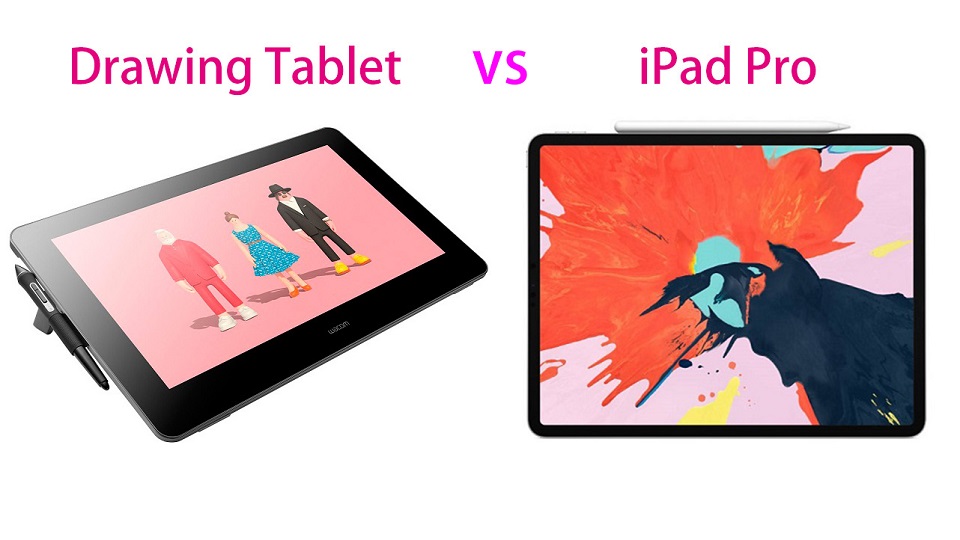
Finding the right drawing tablet can be the key to unlocking your full creative potential. With so many options available, it can be overwhelming to decide which tablet is the best option for you.
Two popular choices on the market are the iPad and tradition drawing tablets.
Drawing tablets like those made by Wacom, Huion, XP-Pen and Veikk allow artists to create gorgeous digital art.
Apple iPad with its Pencil and Procreate painting app, provides the same features in a universal tablet for everyone. Many artists use the iPad as their drawing tablet of choice.
Should you get a graphic tablet or an iPad for drawing? Which is the better tablet for an artist?
In fact, they are all good for drawing. But both have their pros and cons, so it can be tricky to determine which one is best suited for you.
In this article, we'll talk about the difference between drawing tablets and Ipads. Then you can make an informed choice depends on your requirement and budget.
Two types of drawing tablets
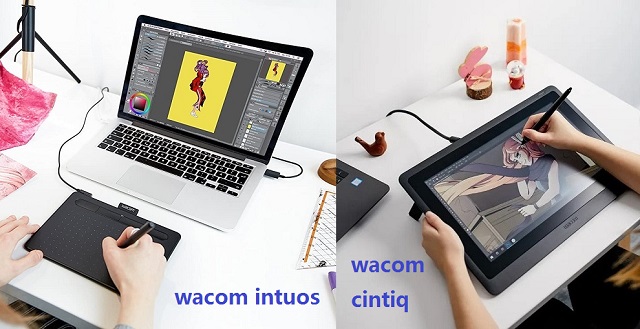
Before the Apple Pencil present in 2015, there were two options for graphic artists who wanted to use a computer.
One is non-screen drawing tablet like Wacom Intuos, which looked like a mouse mat with a stylus that connects to your computer. This let you draw with a pencil-like device and offered pressure sensitivity.
It does not have a built-in screen, so you will need to look at your computer screen while drawing on the tablet.
They are much cheaper, allow wireless connections, will most likely demand more eye-to-hand coordination, but is a worthwhile "first tablet" investment.
The other was drawing tablet with screen like Wacom Cintiq, a secondary screen for your computer that worked with a stylus. Of course they are more expensive than non-screen one.
You can draw directly on the screen with the stylus. This can make the drawing experience feel more intuitive and natural, and it can also make it easier to see your work as you create it.
Drawing tablets are compatible with Windows, Mac, and Linux devices, the newest models can works with certain Android and chromebook devices.
What is an ipad?
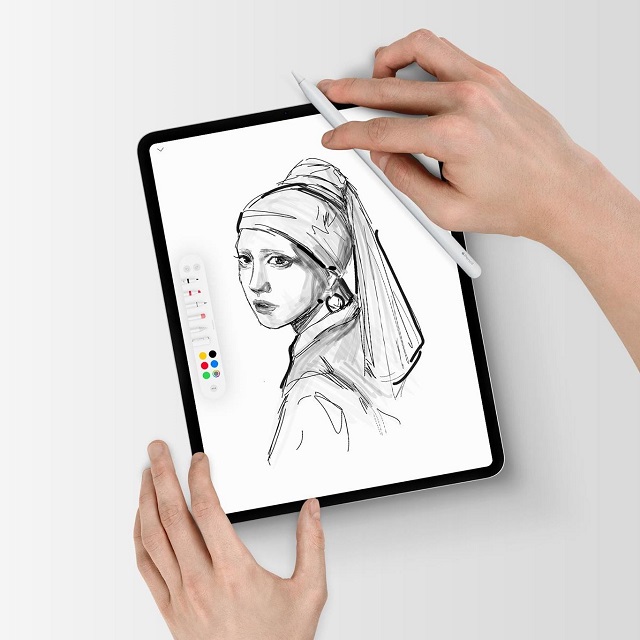
The iPad is a touchscreen tablet computer made by Apple. The original iPad debuted in 2010.
Apple has four iPad product lines: iPad, iPad mini, iPad Air and iPad Pro. All models are available in a variety of colors.
They run Apple iPadOS mobile operating system and have Wi-Fi and Bluetooth connectivity.
Battery life on it is also pretty solid, you can get several hours of drawing out of it without needing to plug it up.
The iPad is a versatile device that can function as both a tablet and a drawing tool.
It offers a variety of drawing and painting apps such as Procreate and Adobe Sketch that can be downloaded directly from the App Store.
The Apple Pencil is also an excellent accessory for the iPad, providing a smooth and responsive drawing experience.
Drawing Tablet vs iPad: Which is better for digital art?
So what exactly are the differences between an iPad and a drawing tablet?
Each of these tablets has their pros and cons and a few distinctive differences.
The best choice between the drawing vs iPad comes down to portability, pressure sensitivity, application compatibility, display size and preferred features.
1. Portability
Drawing tablets are not a standalone tablet, just an input device, so they need to be connected up to a computer to be used.
For example, if you want to use a wacom cintiq pen display with a laptop, it will need power, usb and hdmi cables, This limits its portability.
iPad is an all-in-one tablet, functions independently from your laptop or desktop.
The iPad is also lightweight and portable, making it easy to take with you wherever you go.
So if you travel a lot or if you like to draw in libraries, parks, cafes, trains, etc, then you'll get that with the iPad.
2. Multifunctionality
iPads are versatile devices, with it, you can draw, write, send emails, chat, listen to music, watch movies, play games, and do all kinds of things with it.
On the other hand, drawing tablets are designed exclusively for digital art creation.
3. Software Options
Wacom is used to mirror the screen of your laptop or PC, so you will essentially be using the desktop version of the software such as Adobe Illustrator or Photoshop.
iPad Pro is a mobile device, so you would be able to use various apps which have been specifically adapted to deliver smooth mobile drawing experience.
However, your graphic software options are still limited. For instance, the iPad version of photoshop isn't quite as powerful as the desktop version. some artists get frustrated by having limited layers in Procreate.
In addition, Most professional software options are available only on computers. especially the 3D modeling programs like Blender or Zbrush, you can access a full range of options with a drawing tablet.
4. Screen Size
The largest iPad currently available is the 12.9-inch iPad Pro, which are suffice for casual artists and beginners, some professionals may find it a little cramped for complex projects.
In comparison, drawing tablets offers larger screen sizes, such as the Wacom cintiq 24 pro, Huion Kamvas Pro 24, XP-Pen Artist 24 Pro tablet measuring in at 23.8 inches.
Generous screen is big enough for all canvas size needs. It's almost as if you're sketching on real paper or canvas when you're using it. A big screen is also really convenient for big projects.
5. Display quality and Resolution
most pen tablet monitors comes with full-color gamut-supported IPS displays which are very accurate in terms of color production.
They comes with FullHD, 2.5K and even 4K resolution (High-end model). They are bright and vibrant and very comfortable to look at.
On the other hand, iPads have a superior display than what you get with drawing tablets.
iPads have a mini-LED display with a 2K resolution and 100% DCI-P3 color gamut. Their screen looks beautiful, colors are on point and they are bright enough to be used outdoors.
The 120Hz refresh rate of ipad pro model helps with making the apple pencil strokes feel smoother.
6. Drawing Surface
The iPad has a glossy surface which, when paired with a hard tip on the Pencil, can make drawing feel unnatural compared to pencil on paper.
Of course, this comes down to personal preference. If this doesn't bother you, the Apple Pencil will work just fine.
Or you can apply a matte screen protector which gives a similar paper-like feel.
Professional drawing tablet manufacturers, like Wacom, XP-Pen and Huion knows artists love a little texture on the screen.
So they came with etched glass surface or pre-installed matte screen protector which creates slight resistance while drawing which gives more control over the pen and sounds like a paper.
6. Pressure Sensitivity
The most important feature of a drawing tablet is its pressure sensitivity. The higher the pressure sensitivity, the better you can control the line weight.
Apple doesn't provide a specific pressure sensitivity level for the Apple Pencil. But Pressure sensitivity is there and definitely smooth enough.
Accuracy is essentially perfect, and responsiveness is excellent. The new apple Pencil 2nd gen has 9ms latency while the older 1st gen has 20ms.
These days all drawing tablet manufacturers list 8192 pressure levels. With this higher pressure sensitivity levels, you can have a more control over strokes, get a more accurate and natural drawing experience.
8. Stylus
Apple Pencil is an active stylus whereas the digital pen of drawing tablet is passive.
The active stylus has a battery inside the pen whereas the passive stylus is battery free and use electromagnetic waves from the tablet to transfer energy and data.
As the passive stylus does not have a battery – they do not need charging. On the other hand, apple pencil needs charging, which can be a little annoying!
9. Programmable Buttons
Most drawing tablets usually come with a set of buttons along the side that you can customize with different functions. This can be a huge time-saver, especially when you need to frequently switch back and forth between tasks.
Unfortunately, the iPad lacks this feature. This is a bad thing if you can't do without customizable buttons.
10. Multi-Touch
Touch/gesture is pretty great for digital art. You can zoom in or out with a pinch, pan, rotate your canvas freely. You can tap with two fingers to undo, or three to redo.
If touch controls are a big part of your workflow, only Wacom Cintiq Pro and Intuos Pro model supports it. Regular wacom tablets and other brands doesn't have touch support.
11. Price
large size Pen display monitor can be more expensive than an iPad, you can often find lower-priced options that still offer the features you need.
non-screen Graphics tablets aimed at beginners cost less than $100, while pen display tablets can cost more than $200.
Furthermore, none of the iPads come with the Apple Pencil, so if you want to use a stylus, you'll have to buy it separately, which add significantly to the cost.
The Apple Pencils are US $99 and $129 respectively for the 1st and 2nd gen.
How to use iPad as a drawing tablet for PC?
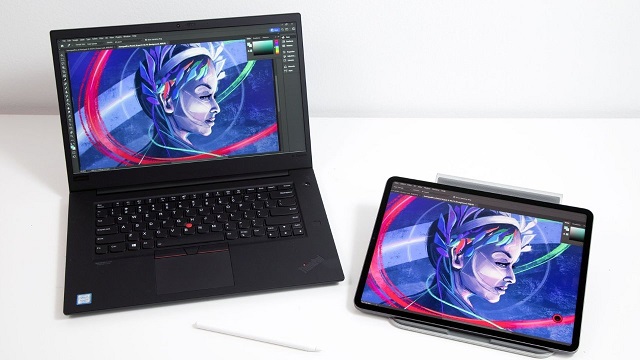
Using your iPad as a drawing pad for pc has many benefits. It allows you to work on a larger canvas, and use the software that are only available on PC.
There are several third-party apps that allow you to connect your iPad to your PC and use it as a graphics tablet.
Some popular options include EasyCanvas, Sidecar, Astropad, Duet Display, and Luna Display.
These apps typically require you to install a companion app on your PC and connect your iPad Pro to your PC via a USB or wireless connection.
Once connected, you can use your iPad's screen as a drawing surface for programs such as Adobe Photoshop, Illustrator, Zbrush and Blender.
However, please keep in mind that the functionality and compatibility of these apps may vary and it's best to check the app's website or reviews before purchasing.
Which is the Best iPad For Drawing?
The standard iPad, iPad mini, iPad Air and iPad Pro can all be used for drawing.
However, by far the best iPad for drawing is the iPad Pro 2022 with the latest M2 chip and apple pencil (2nd Gen).
The iPad Pro also has a much bigger 12.9 inch screen, higher 120Hz refresh rate, compared to the other iPad which is far more comfortable for spending hours drawing and sketching.
Which graphic tablet to get and Why?
Wacom is the industry leader and all of the pros and studios generally use it. We think they are built better and last longer. If you have the budget, get a Wacom device.
If you are a very beginner with digital drawing and you have a limited budget the Huion and XP-Pen are also a great choice. They offer similar functionality at a more affordable price point.
These companies have a range of products, which include both pen tablets and pen displays.
When choosing a screenless tablet, check out Wacom Intuos, Huion inspiroy and XP-Pen Deco Series.
For drawing tablets with screen, check out Wacom Cintiq, Huion Kamvas and XP-Pen Artist Series.
Conclusion
Ultimately, the choice between a graphic tablet and an iPad will depend on your personal preferences, budget, and the specific needs of your workflow.
If you prefer a more versatile and portable setup, an iPad may be a better option.
If you're looking for a premium drawing experience, have a computer that runs programs you need then of course a traditional drawing tablet will be useful.
Whatever you settle on, have fun! Digital painting is the best game we know on the computer.
14:20 Publié dans Bons plan | Lien permanent | Commentaires (0)